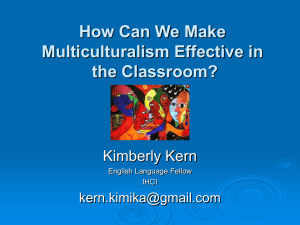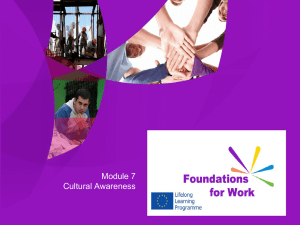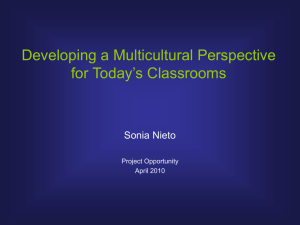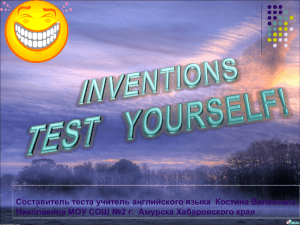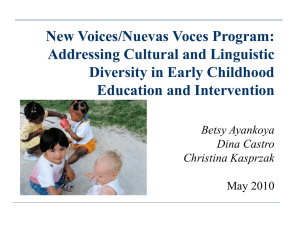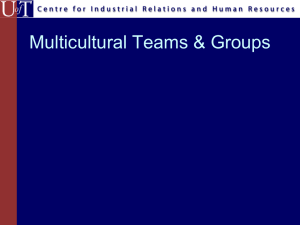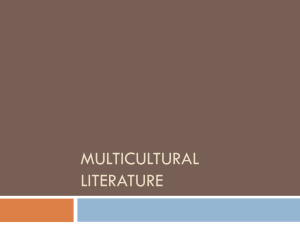Analyzing Multicultural Literature
advertisement
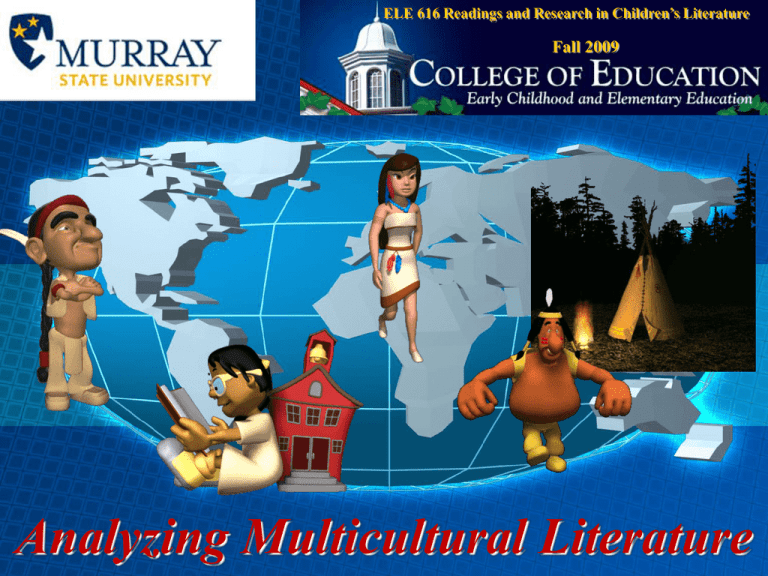
ELE 616 Readings and Research in Children’s Literature Fall 2009 Analyzing Multicultural Literature 2 Why analyze literature? To discover the full spectrum of the content Analyzing Multicultural Literature 3 A little Newtonian physics Isaac Newton first used the word spectrum (Latin for “appearance” or “apparition”) in print in 1671 in describing his experiments in optics. Newton observed that, when a narrow beam of white sunlight strikes the face of a glass prism at an angle, some is reflected and some of the beam passes into and through the glass, emerging as different colored bands. – NationMaster Encyclopedia > Visible light 4 Spectrum requires a prism Estonian composer Arvo Pärt: – I could compare my music to white light which contains all colours. Only a prism can divide the colours and make them appear; this prism could be the spirit of the listener. • about his music: Alina 5 Prism as a filter Historian Doris Kearns Goodwin: – The biographer finds that the past is not simply the past, but a prism through which the subject filters his own changing selfimage. • Goodwin, Doris Kearns (1979). ‘‘Angles of Vision’’, in: Mark Pachter (Ed.), Telling Lives: the biographer’s art. Washington, DC: New Republic Books. Cited in Debate and Reflection: How to Write Journalism History 6 A prism to view the full spectrum of literature Personal Real Invented SMiley face 7 Personal? Do you feel as if you’re involved; part of the action? – That these are real people we’re dealing with—some identifiable personalities Analyzing Multicultural Literature 8 Real? Is there something that makes you feel that this could have happened? – Even when it couldn’t in real life? Analyzing Multicultural Literature 9 Invented? Is this story invented, created by one or more authors? Analyzing Multicultural Literature 10 Smiley Face? Does it seem generic, impersonal? Analyzing Multicultural Literature Two Continuums Real Personal Invented SMiley Face Put ‘em together! Real P e r s o n a l SM i l e y Invented Application to Literature??? . . . and Indians???? 14 Top Left Sector of Matrix Real Up close and personal—and real! P Folklore: Folklore is the body of expressive culture, including tales, e music, dance, legends, oral history, r proverbs, jokes, popular beliefs, customs, material culture, and so forth, s common to a particular population, o comprising the traditions (including n oral traditions) of that culture, subculture, or group. (Wikipedia) a l Invented 15 A rival to Paul Bunyan and John Henry Fink, Mike, 1770?–1823? – American border hero, whose exploits have been so elaborated in legend that the actual facts of his life are difficult to discover. He was born probably at the frontier post of Pittsburgh, took part in the wars against the Native Americans of the Ohio region, and subsequently became a keelboatman on the flatboats of the Ohio and Mississippi rivers. He later turned to trapping. • “Mike Fink.” The Columbia Encyclopedia, Sixth Edition. 2008. Retrieved September 17, 2009 from Encyclopedia.com: http://www.encyclopedia.com/doc/1E1-Fink-Mik.html Analyzing Multicultural Literature 16 Mike Fink tale By “the then beautiful village of Louisville” – Among [a] band of [Indian] outcasts was a Cherokee, who bore the name of Proud Joe . . . Joe still wore, with Indian dignity, his scalplock; he ornamented it with taste, and cherished it, as report said, until some Indian messenger of vengeance should tear it from his head, as expiatory of his numerous crimes. Mike had noticed this peculiarity; and, reaching out his hand, plucked from the revered scalplock a hawk's feather. . . . [Mike’s] ball had cut it clear from his head; the cord around the root, in which were placed feathers and other ornaments, still held it together; the concussion had merely stunned its owner; farther - he had escaped all bodily harm! • “Mike Fink, the Keel-boatman” in Thorpe, T.B. (1854). The Hive of “The Bee Hunter.” A Repository of Sketches, Including Peculiar American Character, Scenery, and Rural Sports. Analyzing Multicultural Literature 17 Bottom Left Sector of Matrix Invented, but Personal P e r s o n a l Real Quality literature, sometimes adaptations, or else original writing, with universal appeal and meaning for everyman and everywoman Invented 18 Analyzing Multicultural Literature 19 Personal, invented and more controversial The “Little House” series – If Pa Ingalls had built his little house on the periphery of an antebellum southern mansion and Mrs. Wilder had described its Black slaves in the same terms she depicted the Osage Indians, her book long ago would have been barred from children’s eyes, or at least sanitized like some editions of Mark Twain’s The Adventures of Huckleberry Finn. Mrs. Wilder’s book even contains the popular variation of General Sheridan’s racist remark about what constitutes a good Indian. • Dennis McAuliffe, Jr., Little House on the Osage Prairie Analyzing Multicultural Literature 20 Top Right of the Matrix Real Smileys! Real Recognizable stories, but unoriginal and shallow 21 A real smiley? Wargin, Kathy Jo The Legend of the Petoskey Stone Sleeping Bear Press, 2004 – The Legend of the Petosky Stone purports to be a legend about a Native American chief from a community on the eastern shore of Lake Michigan. It also purports to tell the origin of the name of the northwest Michigan town of Petoskey, as well as the transfer of that name to a fossilized coral that was made the official state stone. There is absolutely nothing factual or traditional in this book. The language pronunciation guides, the explanations, the translations, are all false. • Review by Lois Beardslee, Oyate 22 Bottom Right of the Matrix Invented smileys [perhaps contrived?] Generic, unoriginal, impersonal, shallow Invented 23 A stilted example? – This title presents a mishmash of Indian cultural snippets, alphabetically and in rhyme, paired with side panels that purport to offer more information about each topic. Abysmally written, with trite error-laden rhymes and boring yet confusing “informational” text, the poor attempts at iambic pentameter highlight this cockamamie piece of dreck . . . • Review by Beverly Slapin in Oyate Comment by Debbie Reese in her blog 24 Functions of multicultural literature Rudine Sims Bishop: – provide knowledge or information – expand how students view the world by offering varying perspectives – promote or develop an appreciation for diversity – give rise to critical inquiry – illuminate human experience • In Using Multiethnic Literature in the K–8 Classroom (ed. Harris, V.J. (1997)), cited by Debbie Reese in Native Americans Today, a ReadWriteThink lesson from NCTE and the International Reading Association Analyzing Multicultural Literature 25 Useful resources
